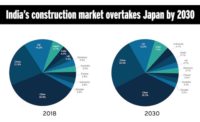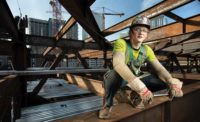Amtrak has embarked on an ambitious two-year plan to triple its annual investment in infrastructure—growing it from $2 billion in fiscal 2023 to more than $6 billion by fiscal 2025. The increased spending is needed to meet its goal to double ridership by 2040.
“To double our ridership means we need to invest about $50 billion into our infrastructure, our maintenance facilities and our fleet nationwide,” said Laura Mason, Amtrak executive vice president of capital delivery.
Mason—who revealed details of Amtrak’s upcoming program at ENR’s second annual NY/NJ Infrastructure Forum held on Sept. 15 in Manhattan—is also doubling the size of her department to handle the flood of project design and delivery to come. The rail operator received $66 billion under the 2021 federal infrastructure law—the largest investment Amtrak has received since its founding more than 50 years ago.
Mason plans to "commit to contract $15 billion in the next 15 months" and "$32 billion to get committed to projects in the next three years."
Increased funding has been a fundamental shift for Amtrak, which has required “agility” in management and growth, Mason said. Compared to years past when funding uncertainty led to projects being broken up into small pieces that lengthened overall construction time, the rail operator now has the ability to launch multiple large programs simultaneously.
 Amtrak will grow capital expenditures from $2.1 billion in fiscal 2023 to $6.5 billion by fiscal 2025.
Amtrak will grow capital expenditures from $2.1 billion in fiscal 2023 to $6.5 billion by fiscal 2025. Image courtesy Amtrak
Projects in the New York-New Jersey region now in procurement and slated to start construction next year include the approximately $1-billion East River Tunnel Rehabilitation project in New York City that was damaged by Superstorm Sandy; the $800-million to $1-billion Connecticut River Bridge Replacement; and several railyard projects ranging from $250 million to $600 million.
One of the most significant projects is the upgrade of Amtrak's Sunnyside Yard Facility in Queens, N.Y., which will improve maintenance, cleaning and inspection of full-length trainsets, with some under canopy cover. Currently, trainsets must be broken up into smaller groupings for this maintenance work. Amtrak has issued the request for qualifications for design-build services on the project, with completion anticipated for 2028.
Requests for proposals and qualifications are expected to be issued this fall for several other large-scale projects, including the $250-million to $500-million Dock Bridge Rehabilitation project and estimated $1-billion Sawtooth Bridges Replacement in New Jersey. Both are components needed for the broader $16.1-billion Gateway Program that will add two rail tunnels beneath the Hudson River between New York and New Jersey.
Due to its age and deterioration, the vertical-fift Dock Bridge, which carries six tracks used by Amtrak, NJ Transit and PATH, is prone to frequent failures that cause significant delays.
Replacement of the 115-year-old Sawtooth bridges in New Jersey “might go down as one of the most complicated projects in this region,” Mason said. “You've got three railroads crossing two other railroads, and if anyone has ever worked on a railroad, you know how hard it is to coordinate track time outages and understand how to go about building it.” Amtrak plans to issue a construction manager-at-risk contract to bring constructability expertise into early stages of the design, she said, adding: “We'll have 30% design out later this year.” The rebuild, expected to take until 2032 to complete, will modernize and expand 1.1 miles of track and boost train speeds from 60 mph to 90 mph.
Mason also announced that the under-construction $2.2-billion Portal North Bridge replacement project in New Jersey, which will double rail capacity between Newark and New York Penn Station, has reached one-third completion, with more than 670,000 hours worked and bridge pier placement underway. Construction will wrap up in 2027.
Amtrak is in the process of hiring thousands of new employees to help execute all the work and capacity upgrades. In addition, Mason said the operator is examining ways to be more “efficient with our maintenance and inspection workforces, and create that pool to support the capital program.”





Post a comment to this article
Report Abusive Comment